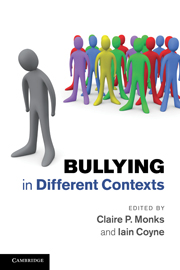Book contents
- Frontmatter
- Contents
- List of figures
- List of tables
- Notes on contributors
- 1 A history of research into bullying
- 2 Peer-victimisation in preschool
- 3 Bullying in schools: thirty years of research
- 4 Peer violence in residential children's homes: a unique experience
- 5 Domestic violence: bullying in the home
- 6 Juvenile dating and violence
- 7 Bullying in prisons: bringing research up to date
- 8 Bullying in the workplace
- 9 Elder abuse and bullying: exploring theoretical and empirical connections
- 10 Cyberbullying
- 11 An overview of bullying and abuse across settings
- Index
- References
11 - An overview of bullying and abuse across settings
Published online by Cambridge University Press: 05 June 2012
- Frontmatter
- Contents
- List of figures
- List of tables
- Notes on contributors
- 1 A history of research into bullying
- 2 Peer-victimisation in preschool
- 3 Bullying in schools: thirty years of research
- 4 Peer violence in residential children's homes: a unique experience
- 5 Domestic violence: bullying in the home
- 6 Juvenile dating and violence
- 7 Bullying in prisons: bringing research up to date
- 8 Bullying in the workplace
- 9 Elder abuse and bullying: exploring theoretical and empirical connections
- 10 Cyberbullying
- 11 An overview of bullying and abuse across settings
- Index
- References
Summary
In editing this book, we have illustrated that bullying and abuse emerge over the lifespan of human beings. It is identified within each of the settings detailed in the book and has serious mental and physical consequences for those involved, as well as associated costs for families, schools, organisations and society. Our vision was to obtain subject matter experts' perspectives on current research and practice within each of these different contexts, as well as debate possible avenues of research and practice that may cross settings. In creating this reference, our vision is that individuals interested in bullying and abuse in one specific context may learn from other contexts and consider adapting methodologies, models, interventions, and so forth to their own area of research or practice. Whilst we accept there will be contextual limitations and unique elements to different settings, we also argue that a greater appreciation of bullying and abuse more widely may enable us to develop common theoretical frameworks and interventions to better understand and reduce this phenomenon.
We are conscious that the book should not spread panic or present the idea that the human experience is plagued with abuse, bullying and neglect. Whilst this is theoretically possible, we cannot envisage the likelihood that the same individual will become a continual victim who is bullied or cyberbullied at school and at home by their siblings, is taken into care and bullied by other children, then, as they develop and start to form relationships, is abused by their partner.
- Type
- Chapter
- Information
- Bullying in Different Contexts , pp. 231 - 256Publisher: Cambridge University PressPrint publication year: 2011
References
- 2
- Cited by



